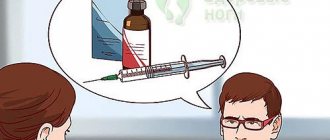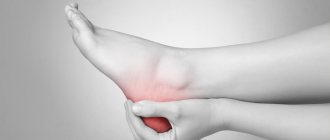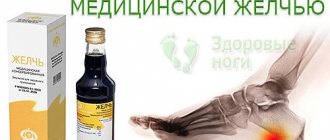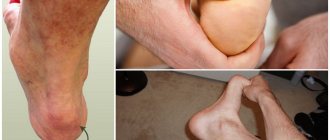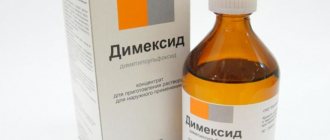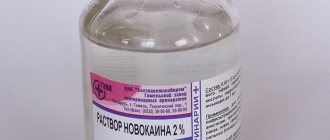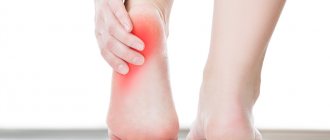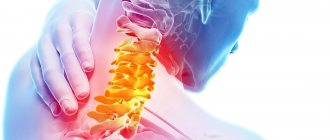- We relieve pain in the heel area in 1-2 sessions
- We use the “gold standard” for heel spur treatment
- We provide an individual approach to each patient
A heel spur (plantar fasciitis, calcific tendinitis of the plantar ligament) is a bone growth in the form of a spike or wedge in the area of the plantar surface of the tubercle of the heel bone. Heel spur belongs to a group of diseases such as enthesopathies - diseases of the attachment of tendons, ligaments, fascia to the bone, in which degenerative and inflammatory changes are observed.
Dimexide against heel spurs
The main active ingredient is Dimethyl sulfoxide, which has anti-inflammatory and antiseptic properties.
The main feature of Dimexide is the ability of its molecules to penetrate the layers of the epidermis and connective tissue, suppressing the development of pathogenic bacteria and inflammatory mediators.
Dimexide also enhances the effect of non-steroidal pharmaceuticals for internal and external use.
There are the following forms of release of the drug:
- Concentrated solution for preparing compresses.
- Rubbing ointment containing up to 70% dimethyl sulfoxide.
- Gel for application to affected fascia and applications.
Dimexide for heel spurs (we will describe how to use this remedy below) has the following effects:
- relieves inflammatory processes inside the heel fascia;
- improves blood circulation;
- normalizes metabolism in epidermal cells and muscle tissue;
- enhances the anti-inflammatory effect of drugs;
- prevents thrombosis;
- eliminates swelling;
- relieves pain and improves foot mobility;
- promotes tissue regeneration;
- resolves bone growth;
- destroys pathogenic microorganisms.
When choosing which medications to treat heel spurs and considering Dimexide as a therapeutic drug, patients should know about its advantages and disadvantages.
The advantages include:
- quickly eliminates pain and relieves inflammation;
- the solution for compresses is easy to prepare;
- duration of procedures is no more than 30 minutes;
- affordable price.
The most frequently cited disadvantages are:
- short period of action;
- the need to perform procedures regularly for at least 2 months;
- high risk of developing allergies and skin burns;
- unpleasant garlic odor of the solution.
Before making a compress for a heel spur with Dimexide, it is recommended to consult a doctor and test for an allergic reaction. It is also important to properly prepare the solution for lotions, strictly observing the specified proportions.
Dimexide for heel spurs: how to dilute? Top 5 best recipes
To get rid of a thorn on the heel, the drug is used as a solution for lotions and rinses. There are many recipes for treating heel spurs at home, including with Dimexide:
A regular compress or rinsing solution.
Recipe: 50 ml of Dimexide + 1 ampoule of lidocaine + 50 ml of ethyl alcohol (vodka) + 100 ml of furatsilin in the form of a solution.
The resulting mixture has a strong antiseptic and analgesic effect. This recipe is suitable for secondary infection of the heel fascia, as well as for wet calluses around the bone spine.
Pain-relieving compress.
Recipe: 50 ml Dimexide + 2 ampoules of lidocaine or ultracaine + 100 ml distilled water.
A lotion with this composition effectively eliminates pain thanks to painkillers. You can make such a compress no more than once a day to avoid an overdose of painkillers.
Anti-inflammatory and pain-relieving compress No. 1.
Recipe: 50 ml Dimexide + 1 ampoule of novocaine + 3-5 ml Diclofenac + 100 ml distilled water.
The non-steroidal drug Diclofenac stops the inflammatory process inside the fascia due to the enhanced action of Dimexide solution. Novocaine blocks pain receptors, relieving pain caused by the impact of the growth on soft tissue.
Anti-inflammatory and pain-relieving compress No. 2
Recipe: 50 ml Dimexide + 1 ampoule of novocaine + 1 ampoule of analgin + 100 ml of distilled water.
Analgin helps with redness of the heel caused by a secondary infection. This compress relieves pain, relieves inflammation and dissolves the thorn.
A powerful anti-inflammatory compress with steroids.
Recipe: 50 ml Dimexide + 1 ampoule of Hydrocortisone + 1 ampoule of novocaine + 50 ml of distilled water.
This recipe involves the use of the steroid drug Hydrocortisone, which quickly relieves inflammation. In some cases, such a compress can become a complete replacement for a heel spur blockade. You can use a solution with steroids no more than 3 times in a row.
Attention! Concentrated Dimexide cannot be used. Its effect on the epidermis causes chemical burns.
Our benefits of treating Heel Spurs
__________________________
TREATMENT EFFECTIVENESS – 97%
97%
Information about Clinic Discounts and Promotions Here!!!
Spurs on the heels - causes of formation
Spurs on the heels , so why - do they form and how to fight these diseases?
Paradoxical as it may seem, the main reason for the appearance of so-called spurs on the heels and the occurrence of pain in the heel bone area is minor ruptures of the plantar ligament (aponeurosis). Such a tear can occur in any person, even at a young age, but those with flat feet or severe physical stress on the feet are most susceptible. The tear is very often accompanied by local inflammation and for this reason, a heel spur is often classified as an inflammation of the ligament - the plantar fascia. Inflammation and tearing of the ligament often results in its thickening and ossification.
Our body has an amazing ability to recover, and in response to a ligament tear, it brings calcium to the site of the tear, which is why a spur grows at the site of the tear . Excess body weight often leads to the appearance of heel spurs. An interesting proven fact: it turns out that women suffer from heel spurs almost significantly more often than men. How can we explain this? Most likely, overweight, and yet in medical practice it is not always possible to reliably determine the cause of the appearance of spurs.
Spurs on the heels: Diagnosis
It is believed that the main way to diagnose heel spurs is radiography. If you follow this principle, then 80% of the population suffers from this disease and everyone needs to be treated. However, this is far from the case. Of these 80%, only a part of patients experience pain, while another fairly significant part does not experience pain - they have so-called “silent spurs”. The final diagnosis is made by the doctor at the appointment by palpation of the heel area.
That is, the presence of a bone growth on the heel (as indicated on the x-ray) does not always require treatment. Bone plaque forms around the ligament and rarely causes pain on its own. Then why do x-rays? X-rays can help your doctor detect other possible causes of heel pain, such as a crack in the heel bone, and prescribe other treatments accordingly.
On the other hand, the absence of bone growth in the presence of heel pain requires additional examination due to the possible presence of diseases such as rheumatoid arthritis, Reiter's syndrome and other systemic diseases. These conditions can also cause heel pain. Therefore, the diagnosis of heel pain should be carried out by a specialist who can distinguish a heel spur from other possible diseases with similar symptoms.
Dimexide: instructions for use for heel spurs
Before applying the lotion, it is recommended to steam your feet in a hot bath with sea salt. After steaming, you can begin preparing the solution according to one of the recipes described above.
Important! Prepare a dose of solution for one use only! The prepared solution cannot be stored, because active ingredients lose their therapeutic effect after contact with air and water. The shelf life of the solution is no more than 1 hour.
To apply the lotion, you need to take a gauze swab or bandage. You cannot use synthetic or colored fabrics, because... the molecules of the substance penetrate into the deep layers of the skin and muscles along with tissue particles and dyes, which can have a detrimental effect on health.
Dimexide, the use of which helps remove the growth for heel spurs, is applied as a lotion to the affected fascia. The gauze swab should be secured with a bandage and left for 20-30 minutes. You cannot leave the tampon on for a longer period to avoid chemical burns.
After removing the lotion, do not wash your feet for 2-3 hours. After this time, the feet should be washed with warm water and a suitable cream from the Pyatkaspor series should be applied to prevent dryness and resorption of the softened growth.
During the treatment process, it is very important to minimize stress on the heels. For this purpose, heel pads are best suited for heel spurs, protecting the fascia of the heels from static and impact loads.
These spur insoles also contribute to optimal load distribution and shock absorption while walking. If you do not use these devices, the treatment will not be effective, because... The heel fascia will be constantly injured, which will lead to the formation of new bone-salt growths.
How to dilute Dimexide for compresses
Dimexide is sold in the form of a solution with a high concentration of the active substance. It cannot be used in its pure form for treatment. If you use only Dimexide to treat heel spurs, then it is diluted in half with lukewarm boiled water, after which it is used as a compress with insulation. In other cases, the concentrate is diluted according to the recipe with strict adherence to the proportions of the incoming components.
It is impossible to prepare compresses for the treatment of heel spurs for future use. One dosage should be used immediately, since after an hour the product loses its healing properties.
Dimexide gel for heel spurs
Despite the fact that Dimexide for heel spurs has positive reviews in most cases, some people do not tolerate the effects of the solution well. Adverse reactions are often associated with a strong garlic odor.
In this case, you can use the product in the form of an ointment and gel. Dimexide gel is used to perform applications that have an anti-inflammatory effect.
A recipe for an application using a gel will tell you how to relieve the pain of a heel spur and prevent side effects that occur when using the drug in the form of a solution.
- Apply Dimexide gel with a pharmaceutical spatula onto a gauze napkin.
- Place a napkin on the heel, cover the top with paper for compresses, film, or a bag.
- Wear socks or insulate the applique with cotton wool.
- Wear for 30-50 minutes, then remove.
Simply rubbing Dimexide ointment also has a healing effect. The active ingredient Dimethyl sulfoxide is included in the following anti-inflammatory external agents: Capsicam, Ketorol-gel, Chondroxide, Dolobene, etc.
Symptoms
The main complaint that patients have with a heel spur is a burning pain when placing weight on the heel; a feeling of a “nail” in the heel is the most common symptom of a heel spur. Lameness often develops. A heel spur significantly affects the patient’s quality of life, especially if it occurs on both legs at once. In this case, if both feet hurt, the patient simply cannot move normally; the only option is to walk on his toes. The main danger of a heel spur lies precisely in the severe pain and limitation of the motor activity of patients against this background.
How to cure a heel spur with Dimexide quickly?
Knowing how to treat heel spurs with Dimexide, patients should not forget that this remedy alone cannot get rid of the growth and stop the inflammation.
Only comprehensive treatment will be effective, including:
- Taking anti-inflammatory drugs.
- The use of non-steroidal ointments.
- Physiotherapy. Treatment of heel spurs with shock wave therapy, laser, and ultrasound gives a good effect.
- Reducing the load on the heel fascia using orthopedic insoles, Strutz instep supports and special heel pads.
To speed up the regeneration of damaged fascia, it is recommended to use a Strasbourg sock at night, which helps keep the connective tissue in a stretched position, in which micro-tears heal.
This comprehensive approach helps prevent painful surgical removal of the heel spur and get rid of the growth.
To prevent the reappearance of spurs, it is necessary to use Pyatkospor Prophylactic cream. The cream contains bile, which prevents the formation of a thorn.
Heel spur - symptoms and treatment
Conservative treatment
Treatment of heel spurs begins with conservative methods.
The main goal of treatment is pain control. As a rule, good results can be achieved through an integrated approach. The main directions in the conservative treatment of heel spurs are foot unloading, drug therapy, physiotherapy, physical therapy and additional methods (taping, massage, night orthoses). The method of unloading the foot is to use orthopedic insoles. Custom-made arch-padded insoles have been shown to be more effective in treatment than prefabricated ones [6]. Soft materials are used for manufacturing; insoles also have a recess in the heel area [1]. Insoles prevent overstretching of the plantar fascia, therefore, they are a pathogenetic method of treatment, unlike heel pads, which do not reduce the tension of the fascia. Wearing orthopedic insoles for heel spurs is recommended both in the acute period and after it subsides to constantly support the foot in the correct position [10].
Women with heel spurs should avoid wearing high-heeled shoes (above 3-5 cm). The optimal heel height is 2-3 cm, the sole thickness is at least 5 mm. Properly selected shoes themselves can reduce pain and provide a lasting positive effect.
Drug therapy. Currently, drugs from the group of non-steroidal anti-inflammatory drugs (NSAIDs) in the form of ointments, creams, and tablet forms are used to treat heel spurs. It is worth noting that the use of NSAIDs is a symptomatic treatment method that does not provide a lasting analgesic effect and does not affect the course of the disease. Often, to relieve pain, patients independently take non-steroidal anti-inflammatory drugs. However, this is dangerous because some NSAIDs have side effects (ulcers and bleeding of the gastrointestinal tract, disturbances in the functioning of the cardiovascular system, blood coagulation system).
The most common treatments for heel spurs are injections of corticosteroids , such as Diprospan and triamcinolone. Infiltration of the site of attachment of the plantar fascia to the heel bone with a solution of an anesthetic and corticosteroid provides a rapid analgesic effect by reducing inflammation. However, this method carries a risk of complications. The most dangerous complication is rupture of the plantar fascia; atrophy of adipose tissue in the injection area is also possible [11]. Given the risks associated with the use of corticosteroids, we can conclude that these drugs are not recommended for use as first-line therapy. Subperiosteal injection of hormonal drugs can also cause complications, for example, necrosis of the calcaneus [1].
Physiotherapy. This method includes thermal procedures (ozokerite), laser therapy, electrophoresis with hyaluronidase, ultrasound with hydrocortisone and shock wave therapy. Recently, shock wave therapy has gained wide popularity. This is a non-invasive treatment method that allows you to quickly reduce or completely eliminate pain. Shock waves are acoustic waves with an extremely high energy peak. The most pronounced therapeutic effect occurs at the tissue interface: fascia - muscle, bone - tendon. Under the influence of a shock wave, blood circulation increases, the permeability of cell membranes changes and cellular ion exchange is restored. Thus, the shock wave therapy method provides anti-inflammatory and anti-edematous effects, and also stimulates regenerative processes, which makes it possible to reduce pain [2]. As a rule, 3 to 5 procedures are required with an interval of 3 days. Patients notice a decrease in pain after the first procedure. We can conclude that shock wave therapy is recommended in the complex treatment of heel spurs.
Therapeutic exercise and massage are aimed at correcting the biomechanics of the body, which directly affects the course of the disease. Physical therapy is used to improve the mobility of the ankle joint, reduce the tension of the plantar fascia and strengthen the muscles responsible for the correct positioning of the foot during movement. Massage as an adjuvant improves metabolic processes in tissues and relieves pain associated with reflex muscle spasms [16].
Taping. A large number of taping methods for heel spurs have been proposed. The advantages of this method are that the analgesic effect is quickly achieved and there are no side effects. As a disadvantage, it can be noted that taping must be performed by a specialist. This method is used as an alternative to orthopedic insoles [17]. However, the effectiveness of this method has not been proven, and the positive results are explained by the placebo effect.
Night orthoses. Used to fix the foot in dorsiflexion while sleeping. This allows you to maintain the plantar fascia in an elongated state, which ensures its fusion without shortening. As a result, during the first steps in the morning, it is possible to avoid repeated microtears of the fascia. However, it should be noted that this method has not been fully studied [8].
Surgery
In most cases, conservative treatment gives an effect in the first weeks, less often within a month from the start of treatment. Some authors believe that the failure of conservative treatment for more than 12 months is an indication for surgical treatment. The main surgical treatment for heel spurs is proximal plantar fasciotomy .
Before the operation, a detailed medical history is taken and the presence of chronic diseases such as diabetes mellitus and hypertension is determined. The age of the patient must be taken into account in connection with the risks of using anesthesia.
The operation is performed under general anesthesia. An incision of about 5 mm is made on the inner side of the heel and endoscopic instruments are inserted through it. An exit hole is formed on the outer side of the heel. Under video surveillance, part of the plantar fascia is incised to eliminate increased tension in this area. The rehabilitation period lasts on average up to two weeks, stitches are removed after 7-10 days. After surgical treatment, patients are recommended to wear individual orthopedic insoles for life.
Contraindications and side effects from the use of Dimexide
Treatment with Dimexide is contraindicated in the following cases:
- the presence of cardiovascular diseases in the acute stage;
- pregnancy period;
- neurological damage to peripheral nerves;
- individual intolerance.
When the solution is prepared correctly, the drug rarely has side effects. If the proportions are not observed, dry skin, allergic swelling, and rash may appear.
Attention! The solution enhances the effect of alcohol and medications. Before use, you must consult your doctor!
Also remember to take pressure off your heel while walking. High-quality orthopedic insoles with a heel shock absorber are perfect for this.
Contraindications to Dimexide
Before using Dimexide for heel spurs, you must read the instructions for use, since the drug has contraindications. It is used with caution during simultaneous treatment with Aspirin, Nitroglycerin and Streptocide, since the drug enhances the effect of these drugs.
It is prohibited to use Dimexide during pregnancy and breastfeeding, in people with severe liver and kidney disorders, who have suffered a heart attack or stroke. Contraindications also include eye diseases and cardiovascular pathologies. It is recommended to consult a doctor before use.
